Bringing a touch of nature indoors can be incredibly uplifting, and with the right low-maintenance indoor trees, anyone can become a successful plant parent. The Rubber Plant is a popular choice for its ability to thrive in cool indoor temperatures, making it perfect for homes and offices with limited natural light. With proper Rubber Plant care, you can enjoy the beauty and benefits of this stunning houseplant.
Whether you’re looking for a comprehensive Rubber Plant care guide or simply want to learn more about these amazing plants, you’re in the right place. Our goal is to provide you with the knowledge and tips you need to keep your Rubber Plant happy and healthy, so you can enjoy its beauty for years to come. By following our expert advice on Rubber Plant care, you’ll be well on your way to becoming a plant care pro.
With the right care and attention, your Rubber Plant can become a stunning focal point in any room, and as a low-maintenance indoor tree, it’s perfect for busy people who want to bring some greenery into their lives. By choosing the right Rubber Plant care guide, you can ensure your plant receives the best possible care, and with our help, you’ll be enjoying the many benefits of Rubber Plant care in no time.
Key Takeaways
- Rubber Plant care is relatively easy, making it perfect for beginners
- These low-maintenance indoor trees can thrive in cool indoor temperatures
- Proper care and attention are essential for keeping your Rubber Plant happy and healthy
- A comprehensive Rubber Plant care guide can provide you with the knowledge you need to succeed
- With the right care, your Rubber Plant can become a stunning focal point in any room
- Rubber Plant care can have numerous benefits, from air purification to stress reduction
- By following expert advice on Rubber Plant care, you can enjoy the beauty and benefits of these amazing plants
Introduction to Rubber Plants
Rubber Plants, known scientifically as Ficus elastica, are a popular choice for indoor spaces due to their air-purifying properties and low-maintenance care. These plants are a type of evergreen tree that can grow up to 8 feet tall, making them a stunning addition to any room. With their large, dark green leaves, Rubber Plants are not only visually appealing but also help to purify the air, making them a great option for those looking for air-purifying houseplants.
One of the unique aspects of Rubber Plants is their ability to thrive in a variety of conditions, making them a great choice for beginners. When it comes to Rubber Plant propagation, it’s relatively easy to propagate new plants from cuttings or division. This makes it easy to share plants with friends or expand your own collection.
What Makes Rubber Plants Unique?
Rubber Plants are known for their ability to tolerate cool indoor temperatures, making them a great choice for rooms with limited natural light. They are also relatively small, making them a great option for apartments or offices. With proper care, Rubber Plants can live for many years, providing a beautiful and natural touch to any space.
Common Varieties of Rubber Plants
There are several varieties of Rubber Plants, including the Decora and the Robusta. Each variety has its own unique characteristics, but they all share the same basic care requirements. Some popular varieties include:
- Decora: Known for its large, dark green leaves and compact growth habit.
- Robusta: A more vigorous variety with larger leaves and a faster growth rate.
By understanding the different varieties of Rubber plants and their unique characteristics, you can choose the perfect plant for your space and enjoy the many benefits of these amazing air-purifying houseplants.
Ideal Growing Conditions for Rubber Plants
Rubber Plants are known to thrive in a variety of environments, making them a popular choice for indoor spaces, especially living rooms. To ensure your Rubber Plant stays healthy and vibrant, it’s essential to provide it with the right growing conditions. This includes meeting the Ficus elastica light requirements, which involve bright, indirect light, although they can tolerate low light conditions. For optimal growth, it’s recommended to place your Rubber Plant near an east- or west-facing window.
In terms of temperature, the Rubber Plant temperature range is between 65-75°F (18-24°C), making them suitable for most indoor spaces. Humidity levels also play a crucial role, with a preferred range of 50-60%. You can increase the humidity around your plant by placing it on a tray filled with water and pebbles or using a humidifier. By meeting these conditions, you’ll be able to enjoy the benefits of having one of the best plants for living rooms, which include air purification and aesthetic appeal.
For more information on creating a suitable environment for your tropical indoor plants, you can visit trusted houseplant guides that provide detailed tips and advice. By following these guidelines and understanding the specific needs of your Rubber Plant, you’ll be able to create an ideal space for it to grow and thrive.
| Condition | Recommended Level |
|---|---|
| Light | Bright, indirect light |
| Temperature | 65-75°F (18-24°C) |
| Humidity | 50-60% |
Light Requirements
As mentioned earlier, Rubber Plants prefer bright, indirect light, but they can adapt to low light conditions. Direct sunlight can cause the leaves to become scorched, so it’s essential to filter the light using a sheer curtain or shade.
Temperature Preferences
The ideal temperature range for Rubber Plants is between 65-75°F (18-24°C). Avoid placing your plant near heating or cooling vents, fireplaces, or drafty windows, as this can cause temperature fluctuations.
Humidity Levels
Rubber Plants prefer a humid environment, with a relative humidity of 50-60%. You can increase the humidity around your plant by using a humidifier or placing the plant on a tray filled with water and pebbles.
Watering Techniques for Healthy Growth
Proper watering is crucial for the health and longevity of your Rubber Plant. A well-planned Rubber Plant watering schedule can help prevent overwatering, which can be detrimental to the plant. Low-maintenance indoor trees like Rubber Plants require careful attention to their watering needs to thrive.
When it comes to watering your Rubber Plant, it’s essential to strike a balance. Overwatering can cause root rot, while underwatering can lead to stressed plants. Air-purifying houseplants like Rubber Plants prefer well-draining soil to prevent waterlogged roots. To create a suitable watering schedule, consider the following factors:
- Soil moisture: Check the soil daily, and water only when it feels dry to the touch.
- Light exposure: Plants in brighter locations may require more frequent watering.
- Temperature: Warmer temperatures can increase transpiration, leading to increased watering needs.
By understanding these factors and adjusting your watering schedule accordingly, you can help your Rubber Plant grow healthy and strong. Remember, a happy plant is a well-watered plant, and with the right care, your Rubber Plant can become a beautiful, thriving addition to your indoor space.
With proper care and attention to watering, your Rubber Plant can become a stunning, low-maintenance indoor tree that not only purifies the air but also adds a touch of natural beauty to your home.
| Watering Frequency | Soil Moisture | Light Exposure |
|---|---|---|
| Daily | Dry to the touch | Bright, indirect light |
| Every other day | Moist but not waterlogged | Medium, indirect light |
| Weekly | Damp but not dry | Low, indirect light |
Fertilizing Your Rubber Plant
To keep your Rubber Plant, also known as Ficus elastica, thriving, fertilization is essential. A well-fertilized plant will have lush green leaves and a sturdy stem, making it a great addition to any living room. When it comes to choosing the best fertilizer for your Rubber Plant, consider a balanced, water-soluble fertilizer.
A Rubber Plant care guide will often recommend fertilizing your plant during the growing season, which typically runs from spring to fall. During this time, you can fertilize your plant once a month. However, it’s crucial to dilute the fertilizer to half the recommended strength to avoid burning the roots. For Best plants for living rooms like the Rubber Plant, it’s also important to consider the humidity and light levels in the room when fertilizing.
Here are some tips for fertilizing your Rubber Plant:
- Use a balanced fertilizer with equal amounts of nitrogen, phosphorus, and potassium.
- Fertilize your plant during the growing season, from spring to fall.
- Dilute the fertilizer to half the recommended strength to avoid burning the roots.
By following these tips and using the right fertilizer, you can keep your Rubber Plant healthy and thriving. Remember to always follow the instructions on the fertilizer package and take into account the specific needs of your plant. With proper care and fertilization, your Rubber Plant will be a beautiful and low-maintenance addition to your living room.
| Fertilizer Type | Frequency | Strength |
|---|---|---|
| Water-soluble | Once a month | Half the recommended strength |
| Organic | Every 2 months | Full strength |
Pruning and Maintenance Tips
Pruning is a crucial aspect of caring for your Rubber Plant, as it helps maintain the plant’s shape, promotes healthy growth, and encourages new leaves to grow. Regular pruning can also aid in Rubber Plant propagation, allowing you to share your plant with friends or expand your indoor garden. As pruning rubber plants is an art, it’s essential to learn the right techniques to avoid damaging your plant.
When it comes to pruning, it’s essential to have the right tools. You’ll need a pair of clean, sharp scissors or pruning shears to prevent spreading diseases. Low-maintenance indoor trees, Rubber Plants are relatively easy to care for, but they still require regular maintenance to thrive.
To keep your Rubber Plant healthy and thriving, consider the following tips:
- Prune your plant during the winter months when it’s dormant.
- Remove any dead or damaged leaves to prevent the spread of disease.
- Use the cuttings from pruning to propagate new plants, which can be a great way to share your Air-purifying houseplants with friends and family.
For more information on caring for your Rubber Plant, visittrusted houseplant guidesto learn more about the best practices for nurturing your plant.
Common Pests and Diseases
When it comes to Rubber Plant care, it’s essential to be aware of common pests and diseases that can affect your Ficus elastica. As one of the Best plants for living rooms, Rubber Plants can thrive with proper care, but they can still be susceptible to issues like spider mites, mealybugs, and scale.
Identifying Common Pests
To prevent infestations, it’s crucial to identify common pests early on. Some signs of pest infestations include white, cottony patches on the leaves or stems, or actual sightings of the pests themselves. Regularly inspecting your plant is an essential part of any Rubber Plant care guide.
Prevention and Treatment
Preventing pest infestations is often easier than treating them. Using insecticidal soap or neem oil can help prevent pests from taking hold. If you do find yourself dealing with an infestation, isolate your plant, and treat it with the appropriate solution. By following these tips and staying vigilant, you can keep your Rubber Plant healthy and thriving.
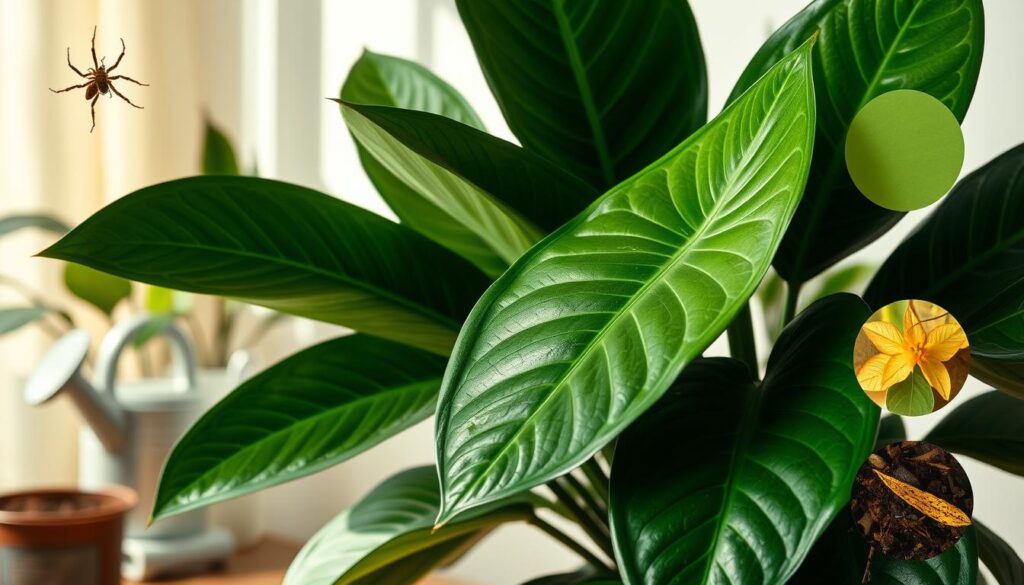
By being aware of common pests and diseases and taking steps to prevent them, you can enjoy the many benefits of having a Rubber Plant in your home, including its air-purifying properties and aesthetic appeal. With the right care and attention, your Ficus elastica can be a beautiful and low-maintenance addition to your living room.
Repotting Your Rubber Plant
As your Rubber Plant grows, it may need to be repotted to provide fresh soil and a larger pot, giving it room to grow. This process is essential for the health and longevity of your plant. Repotting is a crucial step in Rubber Plant propagation, allowing you to refresh the soil and provide a larger pot for your Low-maintenance indoor trees to thrive.
When considering repotting, look for signs that your plant has become pot-bound or the soil has become depleted of nutrients. These signs may include slow growth, yellowing leaves, or water draining too quickly through the soil. By repotting your plant, you can help maintain its status as one of the excellent Air-purifying houseplants, improving indoor air quality and aesthetic appeal.
Signs It’s Time to Repot
- The plant has outgrown its current pot, with roots visible on the surface or growing out of the drainage holes.
- The soil is depleted of nutrients, causing slow growth or yellowing leaves.
- Water drains too quickly through the soil, indicating it’s time for fresh potting mix.
How to Repot Correctly
To repot your Rubber Plant correctly, choose a pot that is only slightly larger than the current one, as these plants prefer to be slightly root-bound. Select a well-draining potting mix, and gently remove the plant from its old pot, taking care not to damage the roots. Place the plant in its new pot, adding fresh potting mix around the roots. Water thoroughly after repotting to settle the soil.
By following these steps and considering the needs of your Rubber Plant, you can successfully repot your plant, promoting healthy growth and maintaining its role as a beautiful, Low-maintenance indoor tree and effective Air-purifying houseplant.
| Repotting Tips | Benefits |
|---|---|
| Use a well-draining potting mix | Prevents waterlogged soil, reducing the risk of root rot |
| Choose a pot slightly larger than the current one | Prevents the soil from becoming too wet, as the plant prefers to be slightly root-bound |
| Water thoroughly after repotting | Settles the soil, providing enough moisture for the plant to establish itself in its new pot |
Troubleshooting Common Issues
As a Rubber Plant care guide, it’s essential to address common issues that may arise when caring for your Ficus elastica. One of the most common problems is yellowing leaves, which can be caused by overwatering or underwatering. To prevent this, make sure to check the soil moisture regularly and adjust your watering schedule accordingly.
Another issue that may occur is dropping leaves, which can be a sign of stress or changes in the environment. To minimize this, ensure that your Rubber Plant is placed in a stable location with consistent temperatures and humidity levels, making it one of the best plants for living rooms.
Common Issues and Solutions
- Yellowing leaves: Check soil moisture and adjust watering schedule
- Dropping leaves: Ensure stable environment with consistent temperatures and humidity levels
- Stunted growth: Provide sufficient light and fertilize regularly
By following these tips and being mindful of the common issues that may arise, you can keep your Rubber Plant healthy and thriving. Remember to consult a reliable Rubber Plant care guide for more detailed information on caring for your Ficus elastica.
| Issue | Cause | Solution |
|---|---|---|
| Yellowing leaves | Overwatering or underwatering | Adjust watering schedule |
| Dropping leaves | Stress or environmental changes | Ensure stable environment |
| Stunted growth | Insufficient light or fertilization | Provide sufficient light and fertilize regularly |
Conclusion: Enjoying Your Resilient Rubber Plant
As we’ve explored, the Rubber Plant is a remarkable houseplant that can thrive in a variety of indoor environments. With its resilient nature and ability to purify the air, it’s no wonder this low-maintenance indoor tree has become a popular choice for homes and offices alike.
Benefits of Having Rubber Plants Indoors
Beyond their stunning visual appeal, Rubber Plants offer numerous benefits. They’re excellent air purifiers, removing harmful toxins and improving the quality of the air you breathe. Additionally, their calming presence can help reduce stress and promote a sense of well-being in any space.
Final Care Tips for Longevity
To ensure your Rubber Plant continues to flourish for years to come, remember to provide it with the right balance of light, water, and nutrients. Regularly check the soil moisture, and fertilize your plant during the growing season to support its healthy growth. With a little TLC, your resilient Rubber Plant will reward you with its lush, vibrant foliage and purifying benefits.


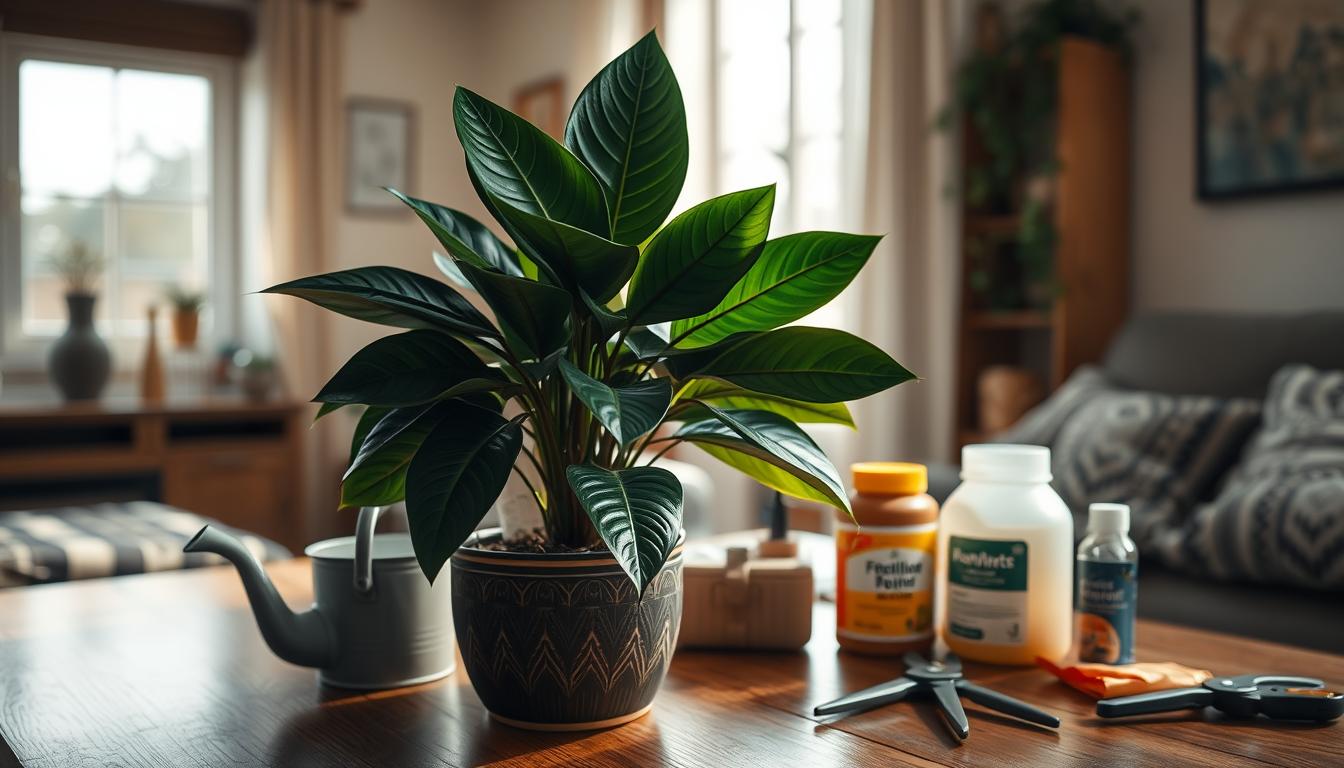
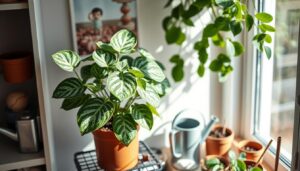
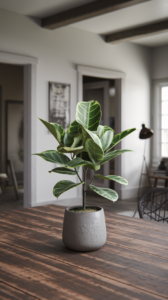
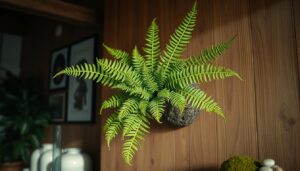
Pingback: 10 Stunning Large Indoor Plants for Statement Decor - Trusted House Plant Guide
Pingback: 10 Best Air-Purifying Houseplants for a Healthier Home - Trusted House Plant Guide
Pingback: 12 Best Houseplants for Beginners to Brighten Your Home - Trusted House Plant Guide
Pingback: How to Care for Indoor Ferns: A Complete Guide - Trusted House Plant Guide
Pingback: How to Fix Nutrient Deficiencies in Your Indoor Plants - Trusted House Plant Guide
Pingback: Troubleshooting Common Indoor Plant Problems: A Comprehensive Guide - Trusted House Plant Guide
Pingback: Building a Fairy Garden with Miniature Plants: A Whimsical DIY Project - Trusted House Plant Guide
Pingback: Growing Together: Leveraging Community and Resources for Indoor Plant Care - Trusted House Plant Guide
Pingback: Pure Air, Pure Home: The Ultimate Guide to Air-Purifying Indoor Plants - Trusted House Plant Guide
Pingback: Nature's Touch: Transforming Your Living Space with Indoor Plants - Trusted House Plant Guide
Pingback: Repotting Indoor Plants: Mastering the Art of Repotting Your Houseplants - Trusted House Plant Guide
Pingback: Mastering Fiddle Leaf Fig Propagation: A Guide to Cultivating Lush Greenery - Trusted House Plant Guide
Pingback: Green Delight: Exploring the Fascinating Realm of Palm House Plants - Trusted House Plant Guide
Pingback: Optimal Watering Practices for Jade Plants: A Guide for Thriving Succulents - Trusted House Plant Guide
Pingback: Cultivating Ferns Indoors: A Guide to Indoor Fern Care - Trusted House Plant Guide
Pingback: Indoor Garden Gifts: Giving a Healthy Gift Guide - Trusted House Plant Guide
Pingback: "ZZ Plant Magic: Easy Steps to Lush, Healthy Growth" - Trusted House Plant Guide
Pingback: Pests or Nutrient Deficiency? Diagnosing Common Leaf Problems - Trusted House Plant Guide
Pingback: The Ultimate Guide to Indoor Plant Care: 20 Essential Tips - Trusted House Plant Guide
Pingback: Cultivating Green Serenity: A Guide to Indoor Palm Tree Care - Trusted House Plant Guide
Pingback: Succulent Identification: An Introduction to Succulent Care & Gardening - Trusted House Plant Guide
Pingback: Busy Lives, Easy Plants: Top 5 Low-Maintenance Houseplants for the Busy Bee - Trusted House Plant Guide
Pingback: Cutting Edge Care: Mastering Pruning and Cleaning for Healthier Indoor Plants - Trusted House Plant Guide
Pingback: Watering Wisely: Tips for Keeping Your Houseplants Happy and Hydrated - Trusted House Plant Guide
Pingback: Cultivating Natural Defense: Indoor Mosquito Repellent Plants - Trusted House Plant Guide
Pingback: Peace Lily Care in Cool Conditions: How to Keep This Air-Purifying Plant Thriving
Pingback: Green Ambiance: A Guide to the Finest Indoor Flora for Your Home - Trusted House Plant Guide
Pingback: Seasons of Growth: Adapting Your Indoor Plant Care for Each Season - Trusted House Plant Guide
Pingback: 8 Houseplant Trends That Will Dominate 2025 – Get Ahead of the Curve! - Trusted House Plant Guide
Pingback: The Ultimate Beginner's Guide to the Most Wanted Indoor Plant for 2025 - Trusted House Plant Guide
Pingback: The Ultimate Guide to Houseplants: 100 Best Indoor Plants for Every Home - Trusted House Plant Guide
Pingback: 12 Stunning Indoor Succulents and Cacti for Your Home - Trusted House Plant Guide
Pingback: 8 Best Pet-Friendly Houseplants for a Happy Home - Trusted House Plant Guide
Pingback: 10 Best Low-Light Houseplants for a Lush Indoor Oasis - Trusted House Plant Guide
Pingback: 10 Perfect Small Houseplants for Compact Spaces - Trusted House Plant Guide
Pingback: 8 Stunning Flowering Indoor Plants to Brighten Your Home - Trusted House Plant Guide
Pingback: "What Are the Best Low Light Indoor Plants? Discover 10 Perfect Varieties. - Trusted House Plant Guide
Pingback: 10 Gorgeous Houseplants That Thrive in Humidity - Trusted House Plant Guide
Pingback: Non-Toxic Herbs for Indoor Gardens with Pets - Trusted House Plant Guide
Pingback: How to Prune and Harvest Indoor Herbs for Maximum Yield - Trusted House Plant Guide
Pingback: How to Grow Aromatic Herbs Indoors for Cooking - Trusted House Plant Guide
Pingback: Herbs that Thrive on Your Kitchen Windowsill - Trusted House Plant Guide